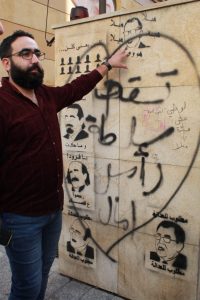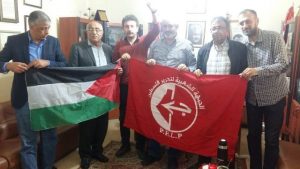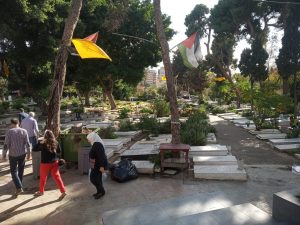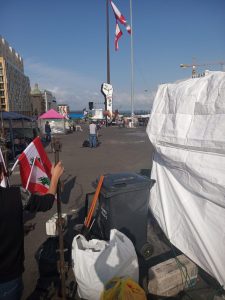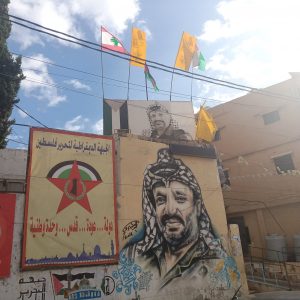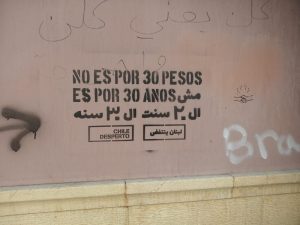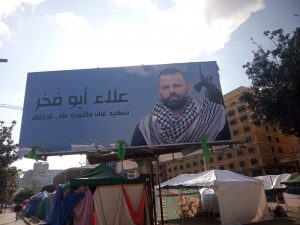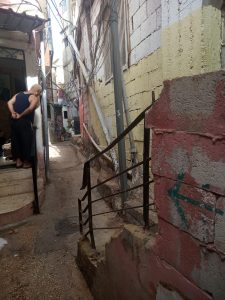
Laborers and the youth are taking the streets worldwide against the rotten capitalist system and its policies which are hostile to the peoples. We had the chance to visit Lebanon, which is now one of these countries in rebellion, and to experience this movement. We participated in the protests in Beirut and Sidon, met with the Lebanese and Palestinian leftist movements, and strengthened our ties with the Lebanese Marxists.
Rotten System and Furious Youth
In all the experiences of different countries, there was a final straw that led to the explosion of class anger. It did not work different in Lebanon. Social anger erupted in Beirut on 18 October when the government, led by Saad Hariri, Lebanon’s richest person, tried to charge taxes per message on WhatsApp.
In the first place, however, a few – only dozens- people responded to the call for a protest. After the vanguard socialist young activists, who also led the protests about the problem in 2016, were dispatched by the police, hundreds and then thousands came together as a reaction in a very short time after those leading activists carried the protest to Hamra Street, which is the heart of the city. On the eighth day of the protests, the Hariri-led government resigned, but the protests have continued for 50 days in all cities of Lebanon. Schools, government offices, banks and universities closed for two weeks.
In Lebanese politics, which is divided into camps of Shiite-Sunni-Christian, it is much more difficult to end the status quo. As a matter of fact, Hariri resigned, but for many months nobody expects the new government to emerge and the system works as it was before. Young people on the streets and on the walls have slogans ‘All of them means all of them’ but there are very critical problems in minds. Who will replace the rotten system and its failed politicians, how will a real change take place? Unless the answers to these questions become clear, it will be inevitable that the wave of protests in Lebanon will stagnate. As a matter of fact, while we were there, we witnessed that the less people are taking part in the protests.
In response to the religious division of society and foreign interventions in Lebanon, the Lebanese flag widely stands out in the protests. The national flag is used as a symbol of the people united, but on the other hand, it shows that there is still need to cover a distance for activists to further radicalize.
The majority of the activists are young. The new generations are well aware of the corruptive and rotten regime and the futurelessness of the youth. Considering the unemployment rate of 35% in Lebanon, which has some of the most expensive cities in the world, one can understand the concerns about the future and the accumulated class rage.
Tendencies to Socialism
We visited a group of comrades who are led by a group of young leaders left Communist Party of Lebanon (CPL). Those comrades reported that CPL has a long history of struggle in which CPL paid heavy prices. But now, it becomes a moderate and do not take any initiative in the struggle that our comrades had to leave the party and establish a new organization. This new group is called The Youth for Change (YfC) and they played critical role to spark this protest wave and had a lot of new members from this movement. CPL , on the other hand, weaken because it has been experiencing loss of meaning and enthusiasm in years.
We took part in a rally, which was organized by YfC and CPL together, in a district called ‘region of banks.’ In these rallies, which have been held in a row for 45 days and the number participants decreased to 300-400 people, we can see the left-wing socialist atmosphere clearly. Che Guevera portraits on the rear windows of the cars and draw sickle and hammers on the walls, punches and banners in red color make you feel the left tendencies and atmosphere clearly, even if you do not know the Arabic alphabet. The majority of the rally is composed of enthusiastic young people aged 18-20 years. Young people from different religions are uncomfortable with religious-sectarian divisions and the whole system in Lebanon. This new generation is caught up in the sphere of socialist discourse. The slogans reflect the class anger; banks, the tax system, income injustice, unemployment and exploitation are aimed at the slogan. The vehement speeches becomes a lecture of politics for this young people on the streets.
Another rally 400 meters away is more like a concert. Although the size of the protests is smaller, the number of people commuting between these two rallies are thousands. Although there are other simultaneous protests at different points of the city, the ones take place in the area of banks, which is the heart of the system full of protestors’ tents and banners, are still the main force that keeps the pulse of the popular movement in Lebanon.
What we saw in Lebanon was that almost everything was the cost of fire. The Lebanese economy has no significant production capacity, and tourism revenues have been largely lost due to turmoil over the last 10-15 years. Everyone says that government spending and corruption are huge. As such, the Lebanese pound depreciates, while inflation, interest rates and unemployment are on the rise. Already since the end of the civil war, the Lebanese laborers, who have lost many social rights through raging neoliberal policies, are becoming increasingly impoverished. There is no such thing as public transport in Lebanon. The coastline has been towed to private companies and there is no place for people can swim. And people should pay for education and health system. There are frequent power and water outages…
In addition to all these, the Shiite-Sunni and Christian political elites are skimming the wealth of the country. Public resources and public rights were looted. The wealth of Beirut’s wealthy neighborhoods is not likely to be overlooked in a small country like Lebanon. However, when you go to the outskirts of Beirut, what you see is a deep poverty.
The Role of Hezbollah
The system in Lebanon was established on balances of civil war, religious sectarianism and the effect of the Israeli occupation. These conditions, gave birth to Hezbollah with the support of Iran . Hezbollah and its leader, Nasrallah, have great prestige because he is leading the national struggle against Israel. In almost every corner of Lebanon, you can see large banners and pictures of political figures in line with the dominant religious identity of that region. In the Shiite regions, of course, Hezbollah has absolute dominance. It is possible to come across pictures of Hezbollah militia who have lost their lives in Syria in almost every street. We even came across Nasrallah’s posters even inside the apartment buildings. In addition, Khomeini’s posters show up in the Shiite regions where Iranian influence is clear.
Hezbollah has taken a very negative attitude from the outset against the people’s uprising and has tried to label the activists as the tongs of America. In a sense, it went down hard from the beginning to prevent the Shiite poor people from participating in the protests. As a matter of the fact, Lebanese comrades agree that if the Shiite neighborhoods , where contains millions of poor laborers, participate in the protests, the struggle will evolve into a revolutionary situation, but we can say that Hezbollah, the most powerful part of the status quo in Lebanon, does not allow it.
The popular slogan “All of them means all of them”, actually, points out Hezbollah too. But, it is noteworthy that while the bourgeois politicians, who are in the government are ridiculed and humiliated on by graffiti and paintings on the walls, Nasrallah is not treated like this. This is because of Hezbollah’s prestige and power as well as its attitude to seek the balances carefully. The majority agree on that there is not any point of confronting the poor Shiite population. Other than that, we were told that Hezbollah was not involved in corruption as much as other parties and that makes a difference.
Conclusion
At the expense of some skipping some interesting details from our observations in Lebanon, we have should focus on that critical question: How can we gather the most important parts of the conclusion? Let us put it this way: Middle East youth has lost hope in the system and wants change. They have expectations from life, but it is not possible to meet them within this system. From Egypt to Lebanon, from Iraq to Morocco, from Algeria to Iran, this reality is similar.
But a change requires a revolution, not less. For the revolution, we need socialist revolutionary parties. We observe that the conditions for building such a revolutionary party in Lebanon are quite favorable. There is a radicalized generation and conditions are suitable for a revolutionary party construction. You have to be tough in a harsh country but Lebanon is not an Iran. So, the ground for party organization are still available.
There is no reason to expect things to get better in Lebanon. On the contrary, the economic crisis will deepen and the people will become poorer. The filth of bourgeois politicians, foreign interventions and religious camps will continue. Only the socialists can change this. If Lebanon expects a good future, it can only be possible with the strengthening of the socialist alternative. The revolutionaries who unite the working people will and build their own parties will be a giant step forward on this path. In this way, we will continue to work devotedly for this internationalist task.
